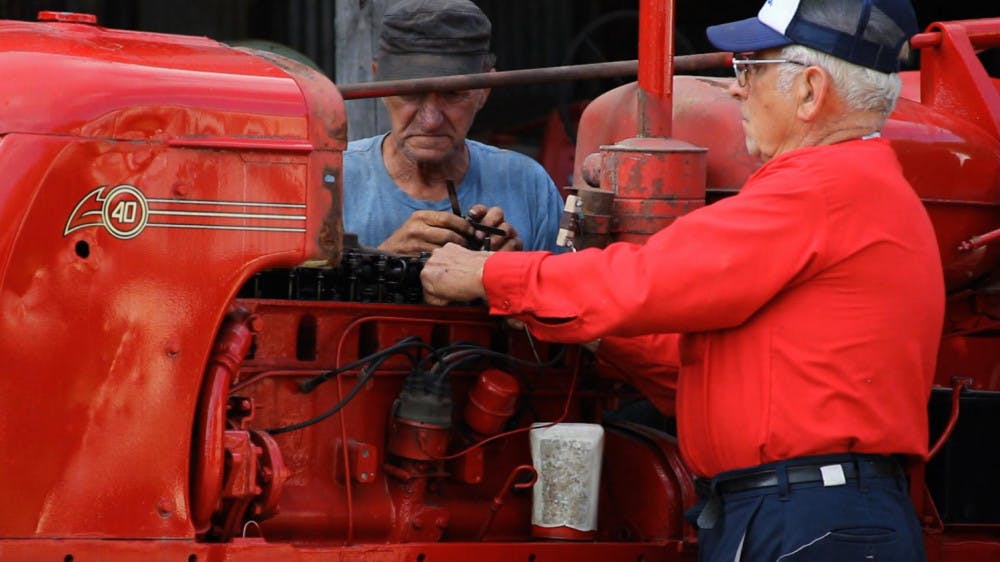“Forgotten Farms” opens with a panoramic view of a green, picturesque landscape — the charming scenery that defines Vermont. Shown at The Marquis on Wednesday, March 8, the film then turns its spotlight to the dairy farmers who own and manage the majority of this land, juxtaposing these beautiful rolling plains with the challenges those farmers face in today’s food system. The film was followed by a discussion with local dairy farmers.
Directed by Dave Simonds and produced by Sarah Gardner, “Forgotten Farms” glimpses into the lives of several hardworking dairy farming families in New England, showing how the confluence of cultural and economic factors introduces hardship and insecurity in their lives. For centuries, farming families served as the backbone of New England agriculture. In recent years, changes in the agroindustry have allowed some agriculturalists to thrive, obscuring the fact that most of New England’s agriculture is under threat.
Since the industrialization of agriculture, New England has lost over ten thousand dairy farms. Many of these farms had been maintained in families, passed down through generations. “You lose more than farms, you lose the history of who they have been, how they got there, what they have,” said one dairy farmer who was interviewed for the film. The farmer referred to his great grandfather, who pioneered his way into the dairy farming industry 75 years prior. At that time, local farmers brought the community together, fostering connection between food producers and consumers. In this symbiotic relationship, the community respected its farmers. Today, two percent of the total population produces food, and not even their next door neighbors understand their work.
As communities become gentrified and small-scale farms disappear, stigmas about dairy farming emerge. According to those interviewed in the film, residents frequently approach them to complain about the smell of manure or to tell them that their work is environmentally harmful. These residents do not know that manure is beneficial for soil, or that dairy farms compose a substantial portion of New England’s agriculture.
The film also touched upon the economic challenges of the industry. Agricultural goods are never adjusted to inflation: in a vicious cycle, the more that farmers produce, the cheaper their milk prices become. “It’s always been sort of a ‘break even’ operation. Grain costs 20 thousand dollars a month, and we spend a million dollars on everything we touch,” a dairy farmer testified in the film. There are times when farmers roll out of bed and know that they can’t make money. And the work never stops.
Harold Giard, former member of the Vermont State Senate (D-Addison) and retired dairy farmer, chronicled the plight of how low milk prices hurt local dairy farmers after the screening.
“Every time a dairy farmer wants something, he needs to milk more cows, because the cost of the piece of equipment is so much money. So we get on this treadmill and continue to run,” he told the audience. Rob Hunt, local dairy farmer who was also at the screening, recalled his life in the past, before small dairy farmers endured financial insecurity.
“The first year I shipped milk was in 1979, and in that year, the average price of milk paid to me was $17.25 per gallon, and that’s what we got paid last year,” Hunt said, noting that in 1979 he could also buy five gallons of Diesel fuel, coffee and a donut for five dollars.
Now, he said, those prices would be unheard of.
“As the margin per hundred pounds gets smaller and smaller, it takes more and more hundred pounds to make a living,” he added. He speculated that these dropping milk prices are why farms industrialize and merge — including his own farm, the property of which he is selling to a larger farm.
Traditionally, dairy farming families hired a few extra helping hands, especially over the summer when teens and adolescents lined up for work. Middlebury’s local dairy farmers recalled how, in the 1970s, there were dozens of dairy farms in their towns that freely hired students. Now there are a few at best, and their mechanized work is unfit for young workers.
“Ten years ago, you could count on one hand the number of dairy farms in Addison County that employed migrant workers. Today, you could count on one hand the number of dairy farmers that do not employ migrant workers,” he said, though the film did not touch on migrant workers.
Marc Cesario, a first-generation farmer in Cornwall, Vermont, whose 1200-acre cattle farm provides beef to Middlebury College, supported the presence of large farms in the dairy industry. “I actually find that I can do a better job of grazing, and it has a better impact on the land, as animal numbers have grown,” he said. “As my herds have grown, it has had a positive impact on soil health and ecology. Growth has been beneficial to me.”
For more information about the film, visit ForgottenFarms.org.
Forgotten Farms at the Marquis highlights cracking US dairy industry

COURTESY PHOTO
After a screening of Forgotten Farms at the Marquis last Wednesday, local farmers spoke about their experiences with a changing dairy industry.
After a screening of Forgotten Farms at the Marquis last Wednesday, local farmers spoke about their experiences with a changing dairy industry.
Comments



